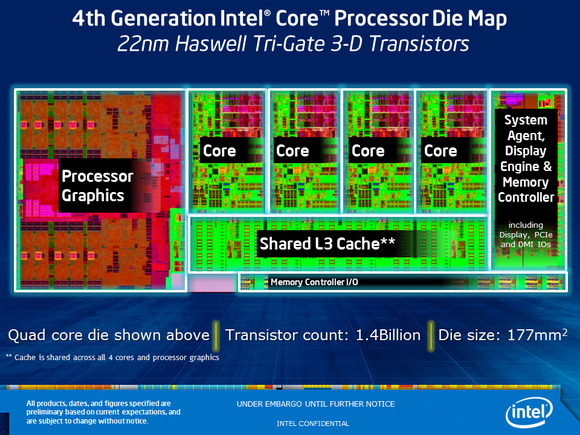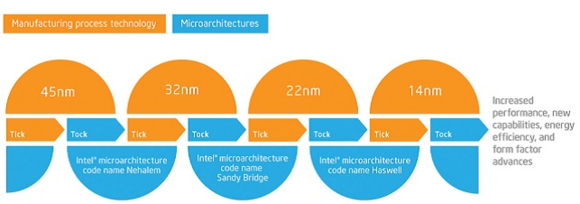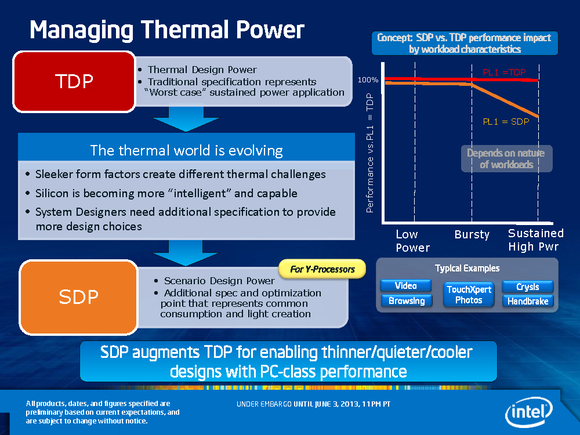
Intel officially introduced its latest Core microprocessor technology on Saturday. Code-named "Haswell," the new CPUs address the PC industry's need for higher-performing parts that consume even lower amounts of power.
But the real question is, Will anyone want one?
While this may be the fourth generation of Intel's Core technology, it's the first to enter what many analysts and pundits are calling the post-PC era. Today's consumers want smaller, thinner, and more portable computing devices, and, to an increasing degree, smartphones and tablets can suffice for many traditional PC tasks—like reading email, browsing web pages, and watching video.
But there are still too many tasks that tablets and smartphones can’t handle. And this is where Intel's fourth-gen Core processors might find a receptive audience. Intel says the new Core CPUs deliver more horsepower than their predecessors, but also consume less power in the service of longer battery life and lower cooling requirements.
The upshot? Tomorrow's mobile PCs might be so thin and light, and last so long on a single charge, and offers so much more utility than Android and iOS devices, you might just buy a Windows notebook before reaching for that phone or tablet.

As you can see from this labeled illustration, Intel has dedicated a lot of silicon to graphics processing.
Inside the line-up
Intel is branding Haswell parts using the same three tiers it's used before: Core i3, Core i5, and Core i7. Intel has also introduced new desktop and mobile core-logic chipsets, dubbed Z87 and Q87, respectively. To evaluate how well Intel delivered on its promises, we built out and benchmarked a desktop machine based on Intel’s brand-new Intel Core i7-4770K. We then compared its performance to Intel’s third-generation Core products (codenamed Ivy Bridge) and AMD’s best desktop processor, the A10-5800K. We also evaluated two new desktop motherboards that use Intel’s Z87 chipset.
Of the major OEMs, HP has announced a few new models that will feature Haswell CPUs, but hasn't revealed which chips those will be. Acer, Dell, Lenovo, and Toshiba, meanwhile, haven't revealed anything, though we expect that will change next week as the giantComputex tradeshow gets underway in China.
Intel's "tick-tock" strategy has the company alternate between releasing a new microarchitecture and then a new manufacturing process.
Because the big-boy manufacturers aren't playing ball, the first retail systems to arrive in the PCWorld Lab came from more nimble boutique manufacturers, including desktop models from Digital Storm, Micro Express, and Origin; and a notebook from CyberPower.
But before we get into benchmark numbers, let’s first examine Intel’s overall strategy and then dive into the details of the Haswell microarchitecture.
Intel’s "tick-tock" strategy
Intel describes its product development model as “tick-tock.” A “tick” occurs every couple of years when the company implements a new manufacturing process that enables it to pack more transistors into the same silicon real estate. A “tock” is the alternate cycle—when Intel introduces an entirely new microarchitecture.
Intel’s Sandy Bridge microarchitecture, introduced in early 2011, was a "tock" built using a 32nm manufacturing process. The Ivy Bridge series, which arrived in April 2012, marked a “tick” as Intel moved from a 32nm manufacturing process to a 22nm process. Haswell chips will be built using this same technology until the next "tick," when Intel perfects its 14nm manufacturing process. The new CPUs based on that technology will be dubbed Broadwell.
Intel will continue to ship earlier generations of its CPUs, and you might be surprised to learn that some of those earlier chips are considerably more powerful than Haswell. The Haswell parts Intel has announced to date have up to four cores, with hyperthreading support. Hyperthreading is an Intel technology that allows the PC’s operating system to address one virtual core for each one of the CPU’s physical cores.
Intel’s Core i7-3930K, -3960X, and -3970X CPUs—desktop CPUs based on the Sandy Bridge-E microarchitecture—are all hexacore parts that support hyperthreading. An operating system running on these CPUs can address a total of 12 cores (six physical and six virtual). Intel designates its absolute fastest CPUs as Extreme Edition CPUs, but the company has not indicated whether it will build Extreme Edition Haswell chips.
Haswell’s Architectural Changes
Intel has introduced four series of mobile processors and four series of desktop processors. The entire family features an integrated voltage regulator that will significantly reduce power consumption while simultaneously eliminating as many as seven other integrated circuits from the motherboard. Intel says this feature will give laptops 50 percent more battery life.
Intel has traditionally used the term TDP (thermal design power) to specify how much electrical power a computer must be able to dissipate in a worst-case scenario—namely, while the CPU is operating at its maximum speed for a sustained period. The company is now introducing a new specification, SDP (scenario design power), that indicates how much power a computer must be able to dissipate while being used for media consumption and “light creation.” Intel will use the SDP spec for CPUs powering tablets and notebooks with detachable displays (Intel describes these as “behind the glass” devices).
Intel has come up with a new thermal specification for CPUs that will operate in tablets and notebooks with detachable displays.
Mobile Haswell processors with TDPs of 15 and 28 watts (or SDPs of six watts or less) feature a
Platform Controller Hub (PCH) integrated into the same package. The PCH, more commonly known as the southbridge, handles the computer’s input/output functions, such as USB and audio. Integrating the southbridge into the CPU package reduces the size of the motherboard, allowing for smaller and thinner notebook designs that consume less power. These same parts will be capable of operating at a very low-power state that Intel has dubbed SOix. A notebook in this idle state will consume almost no power, but will wake up to a fully active state within a few hundred milliseconds.
Bottom line
If you just bought a new desktop PC powered by a third-generation Core processor, we see little reason to trash it and upgrade to a Haswell-class rig. If your machine is four or five years old, on the other hand, an upgrade will surely do you good. We just don’t have enough information to make a recommendation with regard to thin-and-light notebooks, because we don’t yet have one to test. Stay tuned on that front.

 Previous page
Previous page Back to top
Back to top







